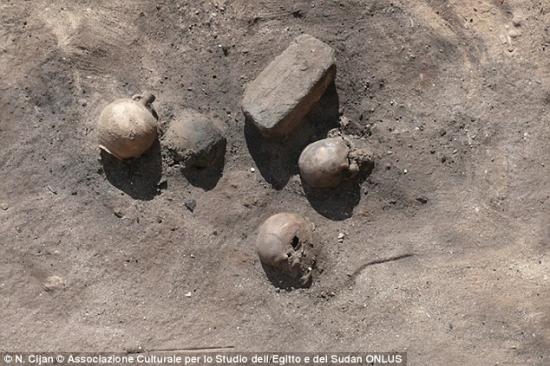Burnt corpses reveal a 3rd century burial plot built to 'prevent the apocalypse'
Jonathan O'Callaghan
Source - http://www.dailymail.co.uk/sciencetech/article-2660085/Cyprian-Plague-victims-unearthed-Egypt-Burnt-corpses-reveal-3rd-century-burial-plot-built-prevent-apocalypse.html
-
Italian archaeologists have revealed an ancient burial plot in Luxor, Egypt
-
The 3rd century tomb was used to stop the deadly spread of a pandemic
-
The Cyprian Plague killed 5,000 people a day at its peak from 250 to 271 AD
-
The disease was believed to be smallpox, which was eradicated in 1979
-
At the time, St Cyprian said it could signal the 'passing away of the world'
From 250 to 271 AD up to 5,000 people died each day in Rome not from war and famine, but from a deadly pandemic that would later be known as the Plague of Cyprian.
And now archaeologists have found the remains of what appears to be victims of the widespread disease, in a pit in Luxor, Egypt.
Kilns used to produce lime to cover the victims were also found, alongside a bonfire where stricken people were burned in order to stop the spread of the highly infectious disease, dubbed the 'end of worlds' pandemic.

Archaeologists in Egypt have found the remains of victims that were struck down by the Plague pf Cyprian in the latter half of the 3rd century. The victims were burned and covered in lime to prevent the deadly disease from spreading. Here can be seen two skulls, two bricks and a jug at the burial site
The find was made by the Italian Archaeological Mission to Luxor (MAIL) team, reported Live Science.
The team, led by Francesco Tiradritti, excavated the tomb, known as the Funerary Complex of Harwa and Akhimenru, from 1997 until 2012.
The monument had been built for an Egyptian grand steward named Harwa in the 7th century BC and it was continually used until it became a plague-burial site in the 3rd Century AD - and was then never used again.
Writing in the Egyptian Archaeology magazine, Tiradritti said using the tomb to dispose of infected corpses ‘gave the monument a lasting bad reputation and doomed it to centuries of oblivion until tomb robbers entered the complex in the early 19th century.’
The Plague of Cyprian raged until 271, by which time it claimed a quarter of Rome’s population - and countless lives elsewhere.
It spread across what is now modern-day Europe and into Africa.
Now believed to have been caused by smallpox, the plague was so devastating that it led the bishop of Carthage at the time, Saint Cyprian for whom the pandemic is named, to lament that it could signal the ‘passing away of the world’.

The kilns to produce lime to cover the bodies were fuelled by the remains of old wooden coffins, such as the one shown here. The find was made by the Italian Archaeological Mission to Luxor (MAIL) team after 15 years of excavations from 1997 to 2012

Oil lamps discovered near the lime kilns, shown here, were used by the stokers who kept the kilns burning to see in the dark. Stokers would have had to keep the kilns burning around the clock for several days in order to produce the lime necessary to cover the bodies
Of the plague, Cyprian explained the rather gruesome ways it would ravage its victims in his essay De mortalitate (On the plague).
'The intestines are shaken with a continual vomiting’ and ‘the eyes are on fire with the ejected blood,’ it read.
In some cases victims would also lose limbs to the disease, while many also eventually died.
The remarkable artefacts found by the archaeologists show the level of fear and panic the plague induced in the locals.
This best disinfectant known at the time was lime, which involved heating limestone to huge temperatures of up to 1,000°C (1,800°F).
The large temperatures, though, required huge amounts of fuel, and in order to produce enough lime to cover all the bodies it seems the locals at the time used coffins, and other artefacts, they found in this tomb to burn.

Bodies were covered with a layer of lime, used as a disinfectant, and kept inside a pillared hallway shown at 1. The three kilns are shown at A, B and C, in part fuelled by both coffin and mummy remains stored at 4. Water was added to the lime at niche 3, while the bonfire to burn the bodies is at 2

Here can be seen a close-up view of lime kiln C, which has a double chamber. It was built along with the other two kilns in order to produce enough lime disinfectant to cover the multitude of human remains that had died in the plague that struck the ancient city of Thebes, now Luxor
PART.2